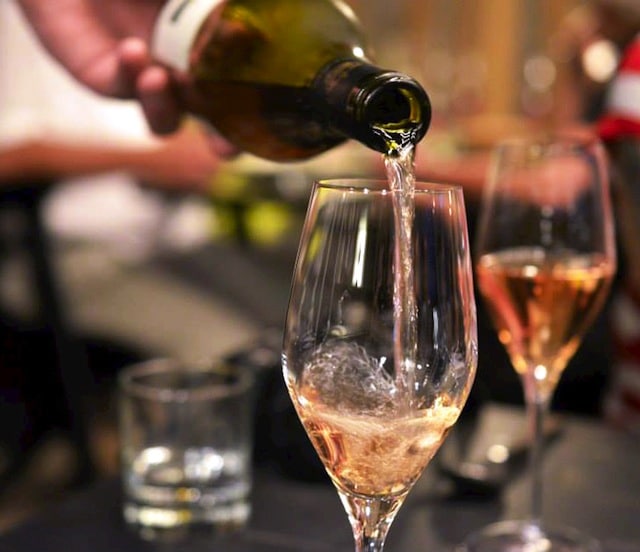
Sommelier pouring wine at Restaurant Radio
While Copenhagen is renowned for its farm-to-table dining scene and mix of traditional dishes, there is a cuisine philosophy taking over the city: The New Nordic Food Movement. Not surprisingly, the mastermind behind the evolution is Claus Meyer, celebrated co-founder of Restaurant Noma (named Best Restaurant in the World in 2010, 2011 and 2012, and Second Best Restaurant in the World in 2013 by Restaurant). He’s also the chef behind Restaurant Radio along with Partners and Head Chefs Jesper Kirketerp and Rasmus Kliim, a venue at which I have the pleasure of dining.
Restaurant Radio – which incorporates the New Nordic Food Movement into many of their dishes — is located next to the old offices of the Danish National Public Radio and Broadcasting, which is where it gets its name from. The restaurant has a very locavore approach, which is at the epicenter of the New Nordic Food Movement philosophy. This light yet satisfying style of cooking focuses on outdoor foraging, beautiful preparation, and using usual ingredients in new ways. There is a large focus on biodynamic vegetables — especially locally-sourced root vegetables typical in Nordic recipes from World War II — as well as fresh seafood and ancient grains. Moreover, Meyer wanted to put the fun back in eating and go back to a time before the landscape became barren from overproduction and outsourcing, and before people looked to eat quick and easy meals instead of delicious dishes made with local, nutritionally-rich ingredients.
Meyer is so passionate about the New Nordic Food Movement he even drafted an official manifesto for it:
- To express the purity, freshness, simplicity and ethics we wish to associate with our region.
- To reflect the changing of the seasons in the meals we make.
- To base our cooking on ingredients and produce whose characteristics are particularly excellent in our climates, landscapes and waters.
- To combine the demand for good taste with modern knowledge of health and well-being.
- To promote Nordic products and the variety of Nordic producers – and to spread the word about their underlying cultures.
- To promote animal welfare and a sound production process in our seas, on our farmland and in the wild.
- To develop potentially new applications of traditional Nordic food products.
- To combine the best in Nordic cookery and culinary traditions with impulses from abroad.
- To combine local self-sufficiency with regional sharing of high-quality products.
- To join forces with consumer representatives, other cooking craftsmen, agriculture, the fishing, food , retail and wholesale industries, researchers, teachers, politicians and authorities on this project for the benefit and advantage of everyone in the Nordic countries.
As Restaurant Radio is touted as one of the top restaurants in Copenhagen, I am expecting something at least semi-pretentious; however, the venue offers a laid-back rustic vibe, with unpolished contrasting light and dark wooden decor in every corner, from the tables to the bar to the walls to the curio cabinet used for storing wine glasses and silverware.
The country atmosphere combined with the nature-inspired artwork goes well with the restaurant’s philosophy, as it helps patrons to feel connected to the land. This is important when enjoying New Nordic cuisine, as it places a strong emphasis on local, seasonal ingredients. As I’m dining at Restaurant Radio in July, I’m told the menu will be focusing on in-season ingredients like cucumber, strawberry, gooseberries, spring cabbage, potato, flouder, fennel, peas and kohlrabi. I’m a firm believer that vegetables can taste better than dessert when they’re fresh, and I’m excited to get started with the experience.
At Restaurant Radio you don’t order off a menu. Instead, you choose whether you would like to do the three-course menu or the five-course menu, with or without wine pairing. Of course, I opt for the five-course menu with wine pairing, which is well-worth the 800 Danish Krones (about $140 USD) for the meal’s satisfying nature.
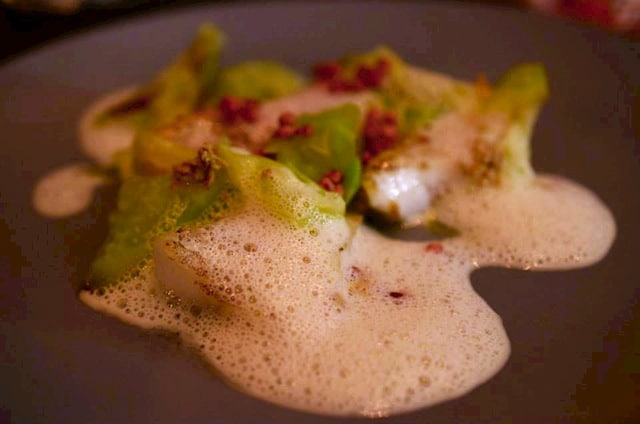
Turbot white fish covered in mussel foam
Our server starts us with a palate teaser of pan-fried turnips served with an airy vinaigrette with mustard seeds and sunflower seeds, crusty bread with house-whipped butter containing caramelized onion, and a glass of white “Flora” wine from Michael Gindl in Niederösterreich, Austria, blending Riesling, Rivaner, Muscat and Sämling 88 (Scheurebe). This is also meant to pair with the first course, a dish of fresh Turbot white fish covered in mussel foam and served with lightly fried cucumber, pickle and elderflower. While the firm and mild fish is made extra savory from the mussel, the vegetables from the restaurant’s fields at Grantoftegaard as well as the sweet and slight tart wine adds a refreshing quality. Mixing typical ingredients in new ways, the dish shows just creative you can get with fish and veggies.
When I ask Chef Jesper Kirketerp about how he and his team go about choosing how to pair the different ingredients, he responds, “We are talking to the farmer at the field to know when it is ready for use, and then we are talking in the kitchen about what we would like to do, and which flavors and consistency we would like to have on the plate.”
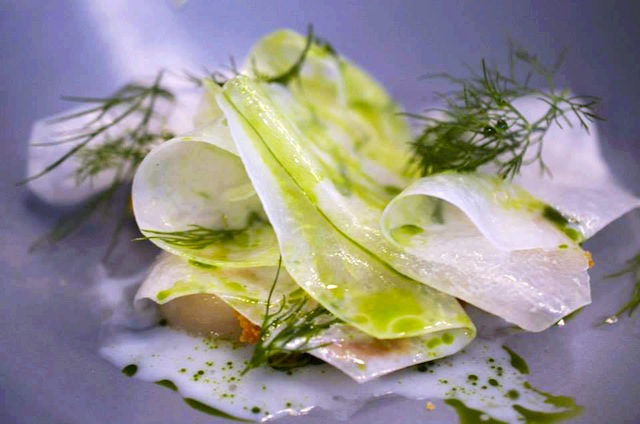
Scallops topped with fresh spring cabbage and dill
Next we’re on to a dish containing my favorite shellfish, scallops. The delicate and plump scallops sit in a juice of buttermilk, salt, dill oil and crunch, and are topped with fresh spring cabbage and dill, truly showcasing New Nordic Cuisine’s affinity for homemade dressings, sustainable seafood and ingredients found right on the Earth’s floor. This course is paired with a 2011 Antonio Lopes Ribeiro Casa de Mouraz ‘Air’ Vinho Verde from Portugal. While the wine is straw-yellow, light-bodied and tangily tart, the dish rounds out the experience with a slow bursting of nutty, creamy flavors that are light yet satisfying.
“The wine pairing is always a fun challenge,” explains Frederik Amorøe, the sommelier for Radio Restaurant. “After discussing each plate in theory with the kitchen and the style of wine that we feel is matched with that and the season, I decide on the type of wine for a given dish. We then try it with our colleagues in both the restaurant and kitchen to get as many opinions on the selections as possible. We are always open to different opinions and try to match not only the food, but also appeal to the broad audience in the restaurant. After all wine is a matter of taste, no matter how much theory and technique you apply to it.”
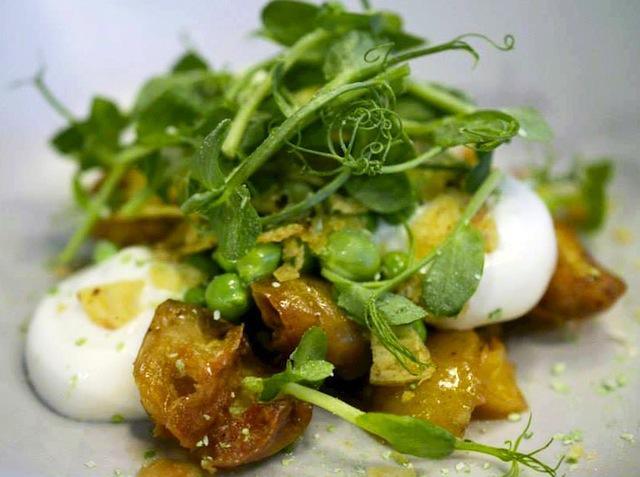
New potatoes with smoked cheese foam
By the third course I’m feeling fulfilled yet eager to continue, as each dish is like a work of epicurious art. Waiting to see what ways Meyer and his team have thought of for surprising flavor combinations and textures is like waiting to see if I’ve won the lottery, with the dishes making me feel like a winner every time. This course features no meat, which is usually a quality I shy away from when ordering; however, the slow-cooked new potatoes — which are actually new, fresh potatoes — served with smoked cheese foam, peas and potato chip bits wins me over. In fact, it becomes my favorite meal. Paired with a traditional French Bourgogne Hautes Côtes de Beaune from 2010, the course is an all-encompassing experience with the tartness from the wine evening out the salty, buttery flavors and warm essence of the food.
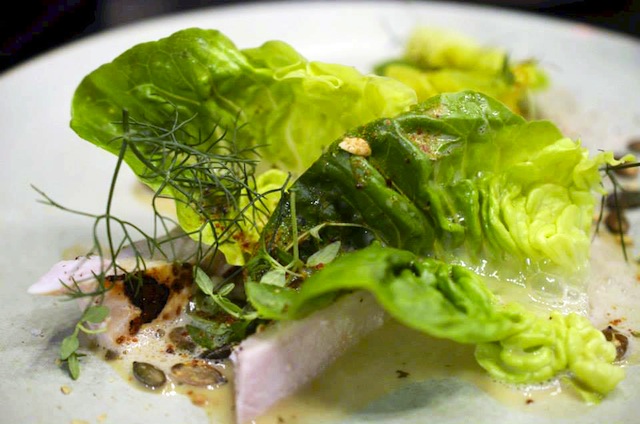
Free-range chicken covered in herbs, gooseberries, crunch and hearts of romaine
In our next course we experience our first red wine, created by a Danish winemaker in California. It’s a 2011 Ampelos Pinor Noir aged in French oak, a voluptuous wine with flavors of sweet tobacco, natural musk and strawberry, with dried cherry enveloping the nose. It’s paired with tender slices of free range chicken covered in herbs, gooseberries, crunch and hearts of romaine. This pairing has a very Earthy quality, and transports me straight to the farm.
Our final course is dessert, which I’m shocked I still have room for. While the portions don’t leave me hungry by any means, this is the type of meal that is fueled by curiosity. What will they think of next?
Dessert: The New Nordic version of Rødgrød med fløde
The wine is is from Germany, a 2011 Weingut Krone, Spätburgunder Spätlese, Weissherbst. It’s sweet without being rich, and is a great choice for the fresh Danish strawberries that sit before me, drenched in a sweet strawberry juice and topped with frozen white chocolate. While to me it tastes like cheesecake, I’m told it’s the New Nordic version of Rødgrød med fløde, a typical dessert in Denmark featuring red summer berries cooked with sugar and stirred with potato starch that becomes gelatinized. The new spin on the traditional treat is a healthier, cleaner version with simple flavors that slowly present themselves instead of aggressively attacking the palate.
What’s really amazing to me about the meal — aside for the dishes and pairings themselves — is how easy and fun Meyer, Kirketerp and Kliim make eating a healthy and moral diet. When people are passionate enough about an issue and have the drive and creativity to solve it in an interesting way, society can experience positive changes. The lucky residents of Denmark are getting to experience a way of eating that goes beyond farm to table and looks to truly promote local business and fresh ways of eating while helping the environment and keeping Nordic traditions alive. My experience at Restaurant Radio is not only delicious, it’s inspiring.
Featured image of Restaurant Radio main course courtesy of Tim Lucas

Jessica Festa is the editor of the travel sites Jessie on a Journey (http://jessieonajourney.com) and Epicure & Culture (http://epicureandculture.com). Along with blogging at We Blog The World, her byline has appeared in publications like Huffington Post, Gadling, Fodor’s, Travel + Escape, Matador, Viator, The Culture-Ist and many others. After getting her BA/MA in Communication from the State University of New York at Albany, she realized she wasn’t really to stop backpacking and made travel her full time job. Some of her most memorable experiences include studying abroad in Sydney, teaching English in Thailand, doing orphanage work in Ghana, hiking her way through South America and traveling solo through Europe. She has a passion for backpacking, adventure, hiking, wine and getting off the beaten path.








